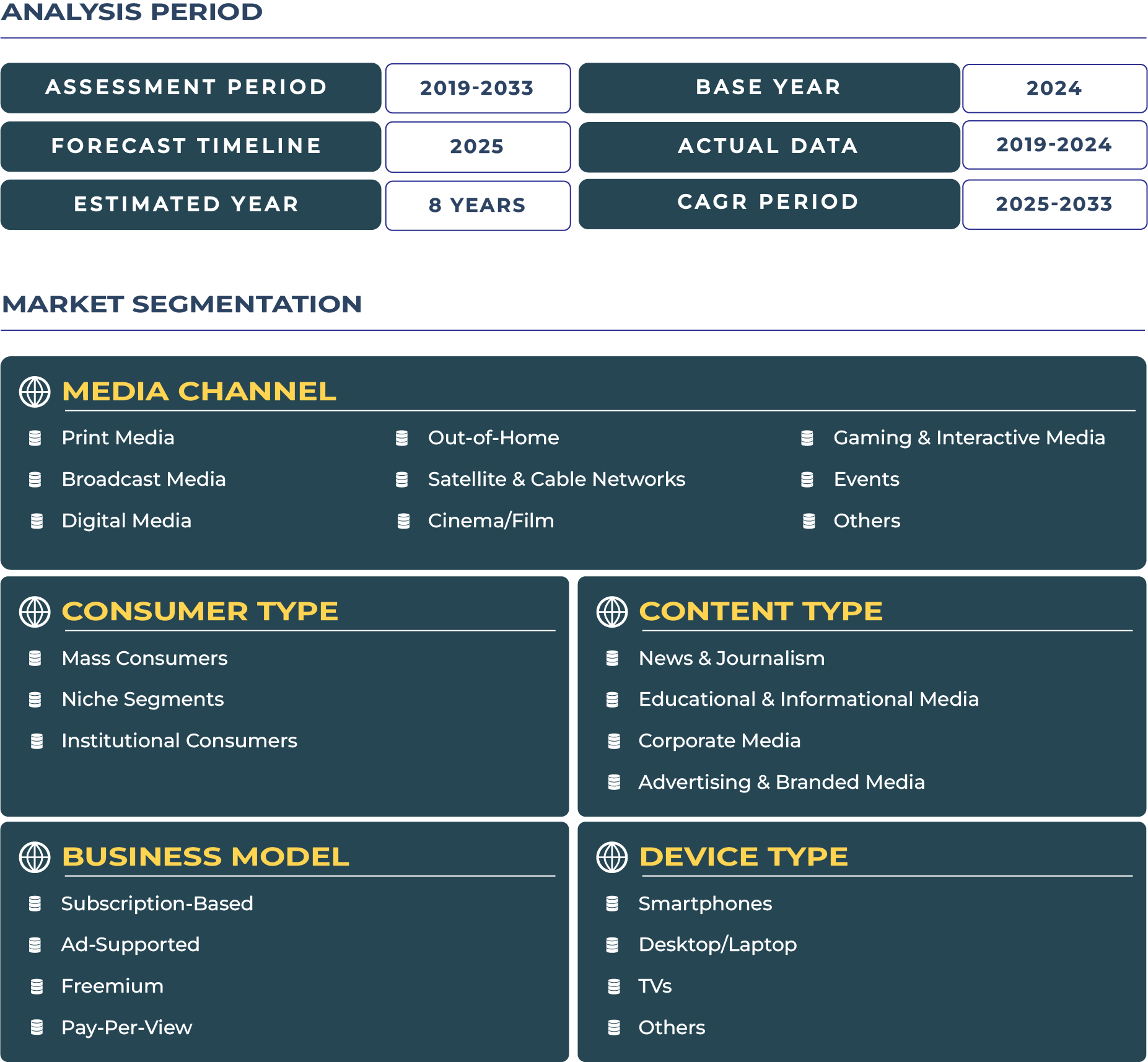Taiwan Media Market Outlook
A Digital-First Economy Powers Media Growth Across Taiwan
Taiwan media industry is at a pivotal inflection point, fueled by technological advancement, a thriving digital economy, and rising consumer sophistication. With a strong GDP per capita projected to cross US$ 36,000 in 2024, Taiwan boasts one of the highest standards of living in Asia, directly contributing to rising media consumption and content diversification. The rollout of nationwide 5G coverage since 2020, combined with internet penetration nearing 94% by 2024, has enabled uninterrupted streaming, mobile-first experiences, and real-time digital interactivity. Disposable income is increasingly channeled into premium subscriptions, on-demand content, gaming, and mobile entertainment. Advertising spend continues to rise, expected to reach NT$ 140 billion by 2027, with over 68% allocated to digital media, reflecting a broader pivot toward performance-driven, data-led advertising.
From 2025 to 2033, the Taiwan media market is forecast to grow at a CAGR of XX.9%, driven by 5G adoption, generational shifts, and hyper-targeted content delivery.
Changing Demographics Reshape Media Preferences and Channel Engagement
Taiwan’s aging population is balanced by a tech-savvy Gen Z and Millennial demographic that consumes content across devices. Urban audiences in Taipei, Kaohsiung, and Taichung exhibit strong preferences for OTT content, streaming music, and influencer-led short-form videos, while older demographics still rely on terrestrial TV and traditional news portals. Interestingly, Taiwan shows high dual-screen behavior—viewers often watch content on TV while browsing social media on mobile. Consumers prefer informative, interactive, and locally contextualized content across Mandarin and Taiwanese Hokkien languages, signaling strong demand for culturally resonant narratives.
Media Channels Adapt Through Digitization and Convergence
Taiwan’s media landscape spans television, OTT, social media, print, and radio—with each platform undergoing digital evolution. Leading terrestrial broadcasters like Sanlih E-Television (SET) and TVBS have expanded into YouTube and live streaming platforms to sustain relevance. For example, SET’s YouTube network surpassed 8 million subscribers in 2024, driven by serialized dramas and news livestreams. The OTT segment is particularly vibrant, led by myVideo, LINE TV, Netflix, and friDay Video. Netflix Taiwan has aggressively invested in original Mandarin productions—its 2023 crime series Copycat Killer drew massive regional attention and boosted local subscriptions.
Telecom operators like Chunghwa Telecom and FarEasTone are integrating media into broadband packages, offering bundled streaming and IPTV solutions through platforms like Hami Video. This convergence of telco-media offerings is unlocking new revenue streams and improving accessibility in suburban areas. Radio still holds niche influence in daily commutes and rural areas, while legacy print publications like Apple Daily (now digital) and Liberty Times are adopting subscription models, podcasting, and AI-generated summaries.
Media Consumption: Streaming, Social, and Self-Made Content
Taiwanese consumers have a high appetite for multi-format digital content. The average user spends over 7 hours daily online, split across streaming, gaming, news, and social engagement. YouTube remains the dominant video platform, followed by Facebook Watch, Instagram Reels, and TikTok. Educational content, beauty vlogs, variety shows, esports, and serialized dramas are popular across age groups. Streaming platforms saw significant subscription surges during the pandemic, and this momentum continues post-COVID, especially with the integration of local payment gateways and family plan discounts.
Self-produced content and live-stream selling (livestream commerce) are increasingly common, blurring the lines between media, entertainment, and e-commerce. Influencers and creators, especially on platforms like TikTok and Dcard (a popular Taiwanese community forum), are now key players in content distribution and product promotions.
Top Media Brands and Subscriber Growth Trajectories
Taiwan’s media brand hierarchy is a mix of traditional broadcasters, new-age platforms, and global disruptors. SET, TVBS, and CTS remain top traditional players, with combined YouTube subscribers exceeding 20 million. In the OTT domain, myVideo and LINE TV lead local preferences with estimated active users crossing 5 million and 3 million respectively as of 2024. Netflix Taiwan has an estimated 1.8 million subscribers, while Disney+, launched in 2021, continues to grow due to its Marvel and Korean drama lineups.
Audio streaming is also growing rapidly. KKBOX, Taiwan’s homegrown music streaming app, boasts over 10 million regional users, dominating Mandarin pop and K-indie playlists. Spotify follows closely, especially among urban youth, with strong podcast consumption trends. Subscriber growth is expected to accelerate with increasing partnerships between these platforms and local telcos, as seen in Spotify’s 2024 collaboration with Taiwan Mobile.
Strategic Moves by Local and Global Players to Capture Market Share
To capture and retain subscribers, media companies in Taiwan are deploying diversified go-to-market strategies. Bundling remains key—platforms like myVideo and Hami Video are often provided free with 5G mobile plans. Freemium models, where users can access limited content with ads, are being used by LINE TV and friDay Video to increase user base before upselling premium tiers.
International players like Netflix and Disney+ are heavily investing in original content localized for Taiwanese audiences. In 2023, Netflix announced a US$ 50 million content fund for Taiwan and began co-producing drama series with local studios. Local creators are being onboarded via mentorship programs, increasing grassroots-level content production.
Local platforms are banking on creator economy integration—supporting influencers with production facilities, monetization programs, and short-form experimentation. KKBOX has introduced AI-powered playlists and fan interaction tools, while myVideo is developing user-generated content contests to increase engagement among younger viewers.
Author: Joseph Gomes Y (Head – Media and Entertainment)
*Research Methodology: This report is based on DataCube’s proprietary 3-stage forecasting model, combining primary research, secondary data triangulation, and expert validation. [Learn more]
Taiwan Media Market Segmentation







